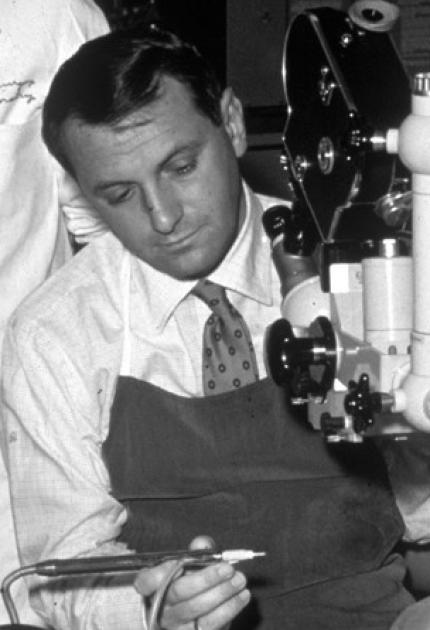
Top 10 Ophthalmologists of All Time
Ophthalmology, the branch of medicine that deals with the diagnosis and treatment of eye-related diseases and disorders, has made great strides in the past century. The following ten individuals are among the most influential and accomplished ophthalmologists in history, each having made significant contributions to the field.
1. Alhazen (965-1039)
Alhazen, also known as Ibn al-Haytham, was a medieval Arab scholar who is credited with being the father of modern optics. He wrote extensively on the properties of light and vision, including the first correct explanation of how the human eye works.
Alhazen's work in optics laid the foundation for future advances in the field and had a significant impact on the development of astronomy, photography, and other fields that rely on the principles of optics. His legacy continues to be celebrated today, and he is remembered as one of the most important scientists in history.

2. Carl Koller (1857-1944)
Carl Koller was an Austrian ophthalmologist who discovered the anesthetic properties of cocaine, a breakthrough that revolutionized the field of ophthalmology. Before Koller's discovery, surgeries on the eye were extremely painful and often unsuccessful due to the patient's involuntary movements during the procedure. With the use of cocaine, Koller was able to perform successful eye surgeries without causing pain to the patient.
Koller's discovery also paved the way for the development of other local anesthetics and pain management techniques, which have had a significant impact on the practice of medicine in general. Today, ophthalmologists continue to use local anesthesia to perform a wide range of procedures, thanks to Koller's pioneering work in the field.

3. Harold Ridley (1906-2001)
Harold Ridley was a British ophthalmologist who invented the intraocular lens (IOL), a device that is implanted into the eye during cataract surgery to replace the natural lens. Ridley's invention was a significant breakthrough, as it allowed cataract patients to regain clear vision without the need for thick glasses or contact lenses.
Ridley's work on IOL implantation has had a profound impact on the field of ophthalmology and has helped millions of people regain their sight. Today, IOLs are a standard part of cataract surgery and are also used to treat other vision problems, such as nearsightedness, farsightedness, and astigmatism.
.jpg)
4. Arnall Patz (1920-2010)
Arnall Patz was an American ophthalmologist who is credited with discovering the link between oxygen therapy for premature infants and the development of retinopathy of prematurity (ROP), a potentially blinding eye disease.
Patz's work on the treatment of ROP had a profound impact on pediatric ophthalmology and has helped countless premature infants retain their sight. His research also paved the way for the development of other treatments for ROP, including laser therapy and anti-VEGF drugs.

5. Gertrude Neumark Rothschild (1920-2009)
Gertrude Neumark Rothschild (1920-2009) was an American physicist and materials scientist who made significant contributions to the development of materials for use in intraocular lenses (IOLs).
Rothschild's work focused on the development of materials that were both biocompatible and had the optical properties necessary for use in IOLs. She developed a number of materials, including polymethyl methacrylate (PMMA), which became the standard material used in IOLs.

6. Jules Stein (1896-1981)
Jules Stein (1896-1981) was an American businessman and philanthropist who made significant contributions to the field of ophthalmology through his support of research and the establishment of the Jules Stein Eye Institute at the University of California, Los Angeles (UCLA).
Stein, who was the founder and CEO of MCA Inc., became interested in ophthalmology after suffering from an eye condition himself. He donated generously to support ophthalmic research and education, and in 1966, he established the Jules Stein Eye Institute at UCLA.

7. Harold Gifford Jr. (1906-1996)
Harold Gifford Jr. (1917-2013) was an American ophthalmologist who made significant contributions to the field of ophthalmology through his research. He is known for several innovations in ophthalmology including the use of fluorescein, tear sac surgery, and the study of exfoliation of the lens capsule. He was a pioneer in the use of local anesthesia in cataract surgery.

8. Charles Kelman (1930-2004)
Charles Kelman was an American ophthalmologist who is credited with inventing phacoemulsification, a technique for cataract removal that uses ultrasonic energy to break up the cloudy lens before suctioning it out of the eye. Kelman's invention was a significant breakthrough, as it allowed for smaller incisions and shorter recovery times compared to traditional cataract surgery.
In recognition of his contributions to the field of ophthalmology, Kelman received numerous honors and awards throughout his career, including the American Academy of Ophthalmology's highest honor, the Laureate Award, in 2003.

9. Patricia Bath (1942-2019)
Patricia Bath was an American ophthalmologist who was the first African American woman to receive a medical patent. Bath invented a device called the Laserphaco Probe, which uses laser technology to remove cataracts. Her invention has helped to restore the vision of countless individuals.
Bath's contributions to the field of ophthalmology and her advocacy for equitable access to eye care have had a profound impact, both in the United States and around the world. In recognition of her achievements, she received numerous awards and honors, including induction into the National Inventors Hall of Fame in 2005.

10. Hermann Snellen (1834-1908)
Hermann Snellen (1834-1908) was a Dutch ophthalmologist who made significant contributions to the field of ophthalmology through his development of the Snellen chart, a tool used to measure visual acuity.
The Snellen chart, which features a series of letters of decreasing size, is still widely used today to measure visual acuity and diagnose vision problems. Snellen's chart was a significant improvement over previous methods for measuring visual acuity, which was often inconsistent and subjective.

(1).jpg)










